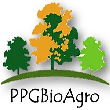Banca de QUALIFICAÇÃO: DANIELA DOMÍCIA DA SILVA COSTA
Uma banca de QUALIFICAÇÃO de MESTRADO foi cadastrada pelo programa.DISCENTE : DANIELA DOMÍCIA DA SILVA COSTA
DATA : 10/12/2021
HORA: 08:30
LOCAL: PPGBioagro
TÍTULO:
Insecticidal potential and anatomical and phytochemical characteristics of Apeiba tibourbou (Aubl.) leaves
PALAVRAS-CHAVES:
Botanical insecticides, Leaf-cutting ants, Aphids, Pente de macaco.
PÁGINAS: 52
GRANDE ÁREA: Ciências Agrárias
ÁREA: Recursos Florestais e Engenharia Florestal
SUBÁREA: Silvicultura
ESPECIALIDADE: Proteção Florestal
RESUMO:
Apeiba tibourbou (Aubl.) belongs to the Malvaceae family and has a variety of chemical compounds that act in the defense mechanism, such as alkaloids, tannins and saponins. However, there are no papers on its insecticidal potential. Thus, the present study presents morphoanatomical, histochemical and phytochemical characteristics present in the leaves of Apeiba tibourbou, and evaluates its insecticidal potential to control Aphis craccivora and Atta sexdens. Histochemical, phytochemical and anatomical analyzes were performed on Apeiba tibourbou leaves according to pre-established protocols. To evaluate the insecticidal potential of Apeiba tibourbou leaves on adult individuals of Aphis craccivora, aqueous and hydroalcoholic extracts were prepared, and subsequently applied topically at concentrations of 0, 2.5%; 5.0% 7.5% and 10%. These individuals were evaluated in periods of 24, 48, 72, 96 and 120 hours. The analysis of insecticidal potential in Atta sexdens was carried out with hydroalcoholic extracts at the same concentrations mentioned for Aphis craccivora, but evaluating leaves and bark also by topical application for a period of 15 days. Histochemical, phytochemical and anatomical analyzes in Apeiba tibourbou leaves allowed the identification of starches, total lipids, phenolic compounds, alkaloids, mucilages, terpenoids and sesquiterpenic lactones, calcium oxalates and trichomes. In the insecticide evaluation, a significant decrease in the survival rate of Aphis craccivora was observed, with more significant results for the hydroalcoholic extracts of the leaves. In bioassays where Atta sexdens workers were subjected to the application of hydroalcoholic extracts from Apeiba tibourbou leaves and bark, it was also observed a decrease in the survival rate of individuals submitted to these extracts when compared to the control. Thus, the insecticidal potential of Apeiba tibourbou extracts can be seen, being a promising source for pest control.
MEMBROS DA BANCA:
Interno - 96420004 - IVONE VIEIRA DA SILVA
Interno - 253817001 - JULIANA GARLET
Externo ao Programa - 257913001 - ADRIANA MATHEUS DA COSTA DE FIGUEIREDO
Externo à Instituição - Caciara Gonzatto Maciel - UFRGS



